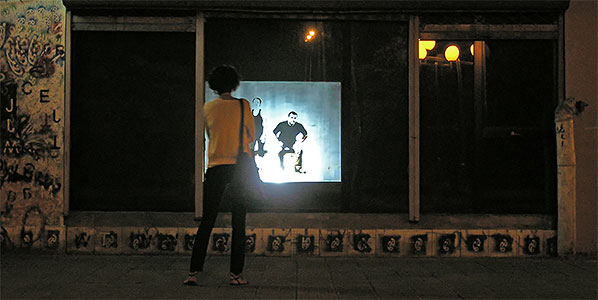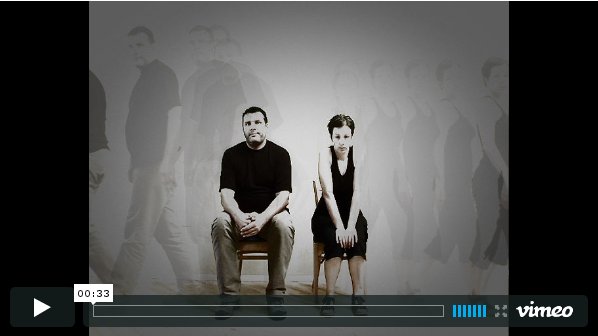



Darko Aleksovski interviews OPA (Slobodanka Stevceska and Denis Saraginovski). OPA (Obsessive Possessive Aggression) is an artistic collaboration, based in Macedonia, whose focus is researching the social, cultural and everyday issues, as well as the ways of looking, thinking and behaving of a certain community in the shifting social and political conditions.
Their project entitled “Bollocks” is a complex and yet very simple interactive installation, made out of a video/image projection in a room in which only one viewer at a time is allowed to see it. The project was first shown at the Authorial Through The Appearance 3 exhibition in Veles, Macedonia (2009). Then it was modified in a second version entitled as “Bollocks for Everybody” for the Small Gallery in Skopje, Macedonia. After that the project was shown at the fifth edition of the AKTO- Festival for Contemporary Arts (2010) where it was awarded with the annual Dragisa Nanevski Award for interdisciplinary achievments. The project was also shown in Studio Golo Brdo, Rovinjsko Selo, Croatia (2011).
Darko Aleksovski: “Bollocks” is a project which was shown on several occasions in art festivals and group exhibitions. Once it was exhibited as “Bollocks for Everybody!”. Can you tell us what was first: its idea, or its title?
OPA: Our initial idea was to relate one specific phenomenon of the Macedonian cultural life: much stronger “gravitation” than in the other parts of the world. It means everything is much harder here, for every single “motion” connected to arts and culture, you need several times more energy compared to other places. It could be because of our institutions, or the specific mentality, or the geographical, political and economic situation of the country – it is a matter of larger analyses. However we didn’t have intention to speak about those reasons into this work, but simply to remind of the existence of the issue. That’s why the work (visually) is about seating and waiting. In the video-image we sit and endlessly wait for something to happen. And when the spectator enters, (s)he triggers the sensor and we both leave the image. So the spectator gets nothing and sees an image of two empty chairs. In the Macedonian colloquial speech you would say the spectator gets “tashak” or “tashaci” (Macedonian: ташак, ташаци). So that is the original title of the work – “Tashaci”, given when the work was completely shaped. “Bollocks” is the best English translation that we could find, but it still doesn’t represent the expression best.
And “Bollocks for Everybody” is the title of the second version of the work, created for the windows of Mala Galerija (The Small Gallery) located in a shopping mall in Skopje.
For our solo presentation in Mala Galerija, we made two different settings of the same work: (1) On the windows of the gallery there was a projected video-image of two empty chairs. When the casual passers by trigger the sensor, our figures were entering the video-image facing the spectator. (2) But inside the gallery we installed the original version of the work, which was intended for the regular visitors of the cultural events, this time invited for the official finissage of the exhibition.

DA: Is the project primarily concerned with the general Macedonian cultural context, or it is dealing with more universal issues?
OPA: We could say that this work is emanated from these local issues, thus it is concerned with the Macedonian cultural context. Translated into the general context it speaks more about the art system, the expectations of the audience, the immateriality of the artwork, about the things that we always miss out, the absurdity, the nothingness…
DA: On one occasion, you say that the inspirational thought about the project is: ‘Art is always in another place’. Does the project speak of ignorant art or ignorant audience?
OPA: It is more about the expectations. About the expectations of where the “real” art should be, what should it look like, what is the art like in other places (always better than our), while we miss the things that are happening (or could happen) here, in front of us. One other interesting interpretation of this thought is that the art is happening during the process of creation. The artist touches it for a moment, and everything that we see as an exhibited object is only a document, a trace of the existence of the art, a way for the artist to share with the rest of the world what (s)he had experienced.

DA: Do you think interactive art is one of the easiest ways to communicate with the audience today?
OPA: It is one of the ways, but it doesn’t have to be the only or the easiest way. Anyway the art today should be in the things that surround us, or incorporated into our everyday life. It should reach us other ways than just through the galleries. It should try to surprise us, confuse us, shake our solid image of the world and make us think and reconsider our attitudes.
DA: How do you feel about joking with/ in art? Do you think a joke in an artwork should be considered a serious statement?
OPA: Humor is one very helpful tool to address the social and the political issues, or the things that bother you and the things that hurt you. It doesn’t mean that if the work involves humor it doesn’t have a serious statement. Thus it is often present in our work. One other tool that we often use in our work is entertainment. Often it is the first thing that catches the audience, it “steals” their time and attention, and than through it we try to convey our message.
DA: Absence is something one finds in many of your works. The absence of connection with reality, absence of objects, even absence of a final artwork, or project. What kind of presence do you think this absence refers to?
OPA: It is really exciting if you succeed, while acting with the art language, to make an artwork that would be communicated but not perceived as an artwork at first. In that case, the work has a direct communication with the audience, not burdened with the fact that art has “special place” in our society. It becomes a kind of subversion of the everyday life – you can experience art without knowing what’s in front of you, yet the situation you have experienced, is an artwork. What we do in our work is about creating “situations”, or often creating the artwork together with our audience. Whether this artwork is either immaterial or difficult to possess.